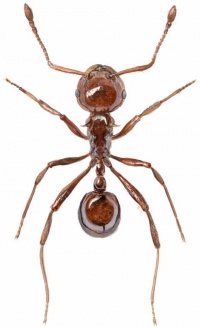Pristomyrmex schoedli
| Pristomyrmex schoedli | |
|---|---|

| |
| Scientific classification | |
| Kingdom: | Animalia |
| Phylum: | Arthropoda |
| Class: | Insecta |
| Order: | Hymenoptera |
| Family: | Formicidae |
| Subfamily: | Myrmicinae |
| Tribe: | Crematogastrini |
| Genus: | Pristomyrmex |
| Species: | P. schoedli |
| Binomial name | |
| Pristomyrmex schoedli Zettel, 2006 | |
Zettel (2006) noted he observed workers of this species foraging on leaves, and that this is a rare sight for Pristomyrmex in general. He also found about one hundred P. schoedli workers in a fallen log. These were collected within 10 minutes, and there were others present as well, showing this species can have colonies of a hundred workers or more.
Identification
Ventral surface of clypeus with strongly prominent tooth at centre. Clypeus without median carina, anterior margin usually with seven (rarely five) small denticles. Pronotum with pair of very long spines (PSL1 0.38-0.44), which are much longer than propodeal spines (PSL2 0.09-0.13). Dorsum of head and alitrunk smooth and polished; dorsum of head with scarce punctures (hair pits). Frontal carinae posteriorly faded; antennal scrobes indistinct. Anterior face of petiolar node distinct from dorsal surface of peduncle. Petiolar node with two or three pairs of hairs.
This species is similar to Pristomyrmex curvulus, but differs in the absence of a median carina on the clypeus and in the reduced frontal carina. From Pristomyrmex longispinus this species differs in the shape of the petiole, in the relatively short propodeal spines and in shorter pilosity. The cephalic index of P. schoedli (113-221) is slightly larger than in P. curvulus and P. longispinus (97-105 and 103-109; data from Wang 2003).
Keys including this Species
Distribution
Distribution based on Regional Taxon Lists
Indo-Australian Region: Philippines (type locality).
Distribution based on AntMaps
Distribution based on AntWeb specimens
Check data from AntWeb
Countries Occupied
| Number of countries occupied by this species based on AntWiki Regional Taxon Lists. In general, fewer countries occupied indicates a narrower range, while more countries indicates a more widespread species. |

|
Estimated Abundance
| Relative abundance based on number of AntMaps records per species (this species within the purple bar). Fewer records (to the left) indicates a less abundant/encountered species while more records (to the right) indicates more abundant/encountered species. |

|
Biology
|
Castes
Nomenclature
The following information is derived from Barry Bolton's Online Catalogue of the Ants of the World.
- schoedli. Pristomyrmex schoedli Zettel, 2006: 64, figs. 5 - 7 (w.) PHILIPPINES.
Unless otherwise noted the text for the remainder of this section is reported from the publication that includes the original description.
Description
Worker
Holotype worker: TL 4.44, HL 1.04, HW 1.15, CI 110, SL 1.17, SI 102, EL 0.22, PW 0.70, AL 1.05, PPW 0.30, PPL 0.32, PPI 94. – Paratype workers (n = 10): TL 4.19-3.41, HL 0.99-1.10, HW 1.12-1.23, CI 113-121, SL 1.19-1.28, SI 103-107, EL 0.21-0.26, PW 0.72-0.75, AL 1.04-1.16, PPW 0.29-0.32, PPL 0.3-0.37, PPI 104-118.
Head: Mandibles smooth and shiny, with or without a few longitudinal rugae. Masticatory margin of mandible with four teeth: strongest apical + second strongest preapical + long diastema + two small basal teeth of similar size. Basal margin of mandible almost straight, lacking tooth. Clypeus short, without median longitudinal carina. Anterior clypeus margin with short median tooth and three (rarely two) pairs of short lateral denticles. Ventral centre of clypeus with prominent tooth. Palp formula 1, 3. Frontal carinae anteriorly strongly developed, posteriorly indistinct and extending caudad at most to level of posterior eye margins, but usually shorter. Antennal scrobes indistinct, laterally not delimited. Frontal lobes absent; antennal insertion entirely exposed. Frons anteriorly with very fine median impression, variably reduced to short longitudinal groove. Antennal scapes, when lying on dorsum of head, slightly surpassing occipital margin of head. Eyes containing c. 10-12 ommatidia in longest row. Pronotum with pair of long spines, PSL1 0.38-0.44. Propodeum with pair of short spines, PSL2 0.09-0.13, distinctly shorter than distance between apices. Dorsum of alitrunk somewhat flattened, behind pronotal spines almost straight in lateral view. Metapleural lobes almost rectangular, with acute or weakly rounded apex. Petiole in profile with long peduncle; peduncle distinct from anterior surface of node; node with weakly developed angles, anterodorsal one on slightly higher level than posterodorsal one. Postpetiole in profile rounded dorsally, in dorsal view slightly broadening from front to back. Dorsum of head smooth and polished, with some very fine hair pits; scrobal areas anteriorly with few transverse wrinkles. Dorsum of alitrunk smooth and polished, with only a few, very fine hair pits. Petiole, postpetiole, and gaster smooth and shiny. Dorsal surfaces of head and alitrunk with numerous long erect or suberect hairs. Dorsum of petiolar node with 2-3 pairs of hairs; dorsum of postpetiole with several pairs. First gastral tergite lacking erect or suberect hairs. A few pairs of forward projecting hairs present near anterior clypeal margin. Scapes and tibiae with numerous erect to suberect hairs. Colour reddish-brown.
Type Material
Holotype (worker): Leyte: Baybay, Leyte State University, c. 50-100 m, Calbiga-a River, 20-21.III.2005, leg. H. Zettel & C. Pangantihon (#422) (Naturhistorisches Museum Wien, Vienna); paratypes: same data, 119 workers (CZW, UPLB, USC); Leyte Pr., Baybay, VISCA, 50 m, above Forestry Department, stream, 11.II.2000, leg. H. Zettel (#235), 2 workers (CZW); same locality and date, leg. S. Schödl (#14), 2 workers (Naturhistorisches Museum Wien, Vienna); Leyte Pr., Baybay, VISCA, 50m, 31.I.2000\ leg. H. Zettel (#222), 1 worker (CZW); Baybay, Leyte State University, c. 50 m, Lago-Lago River, 19.III.2005, leg. H. Zettel & C. Pangantihon (#421), 5 workers (CZW).
References
References based on Global Ant Biodiversity Informatics
- General D. M., and G. D. Alpert. 2012. A synoptic review of the ant genera (Hymenoptera, Formicidae) of the Philippines. Zookeys 200: 1-111.
